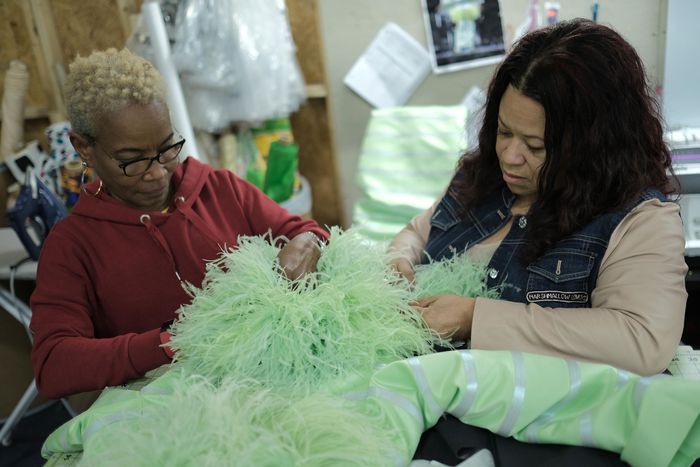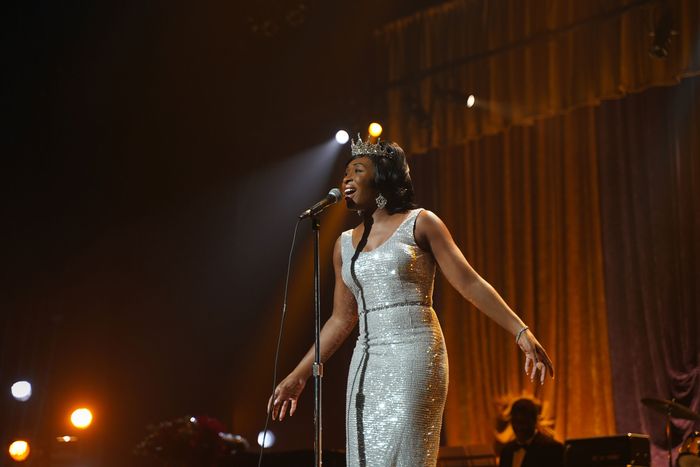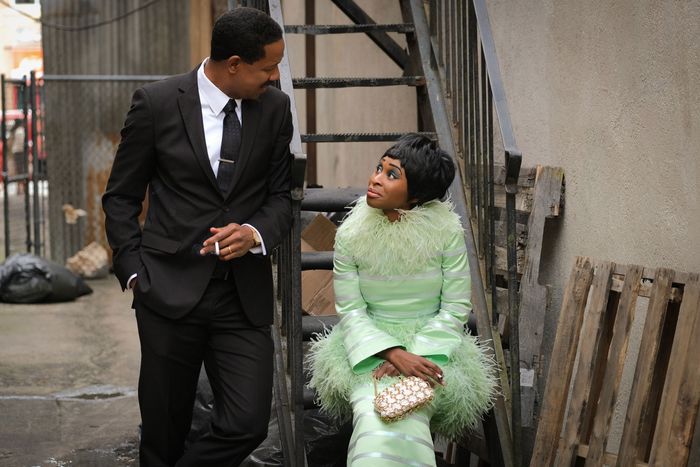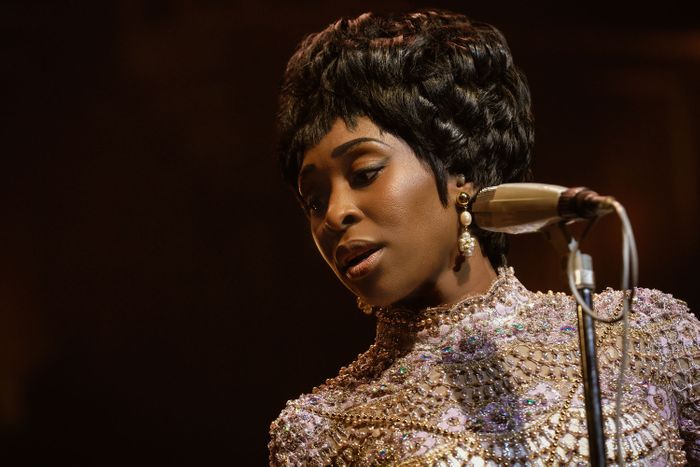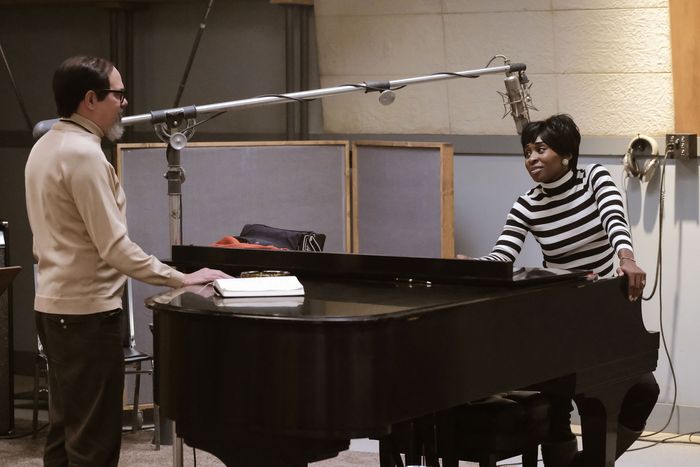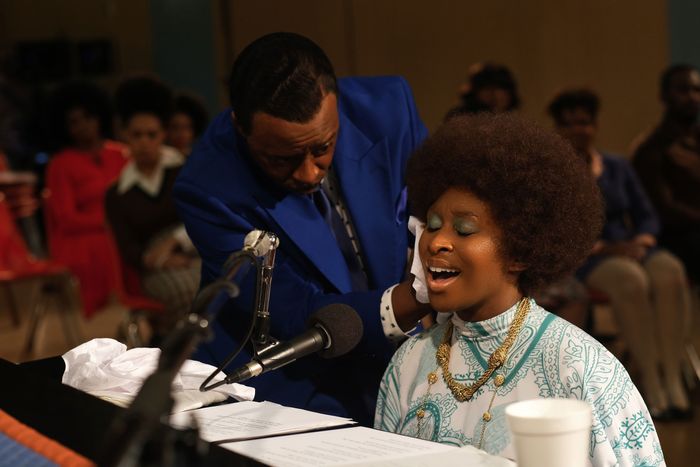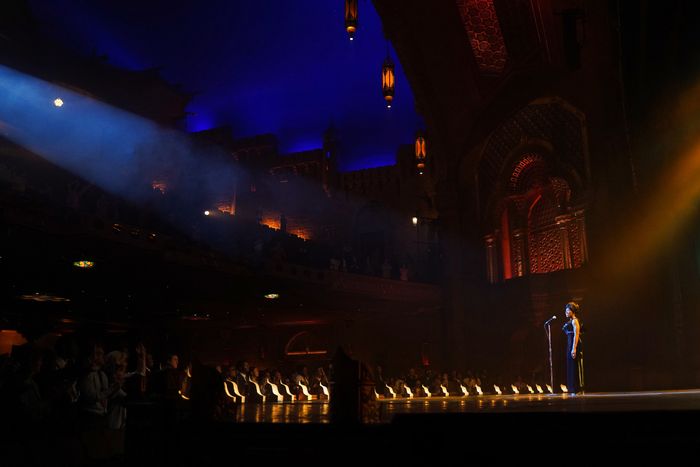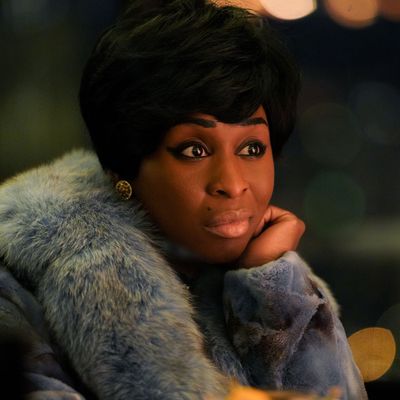
It was Aretha Franklin’s perfectly drawn cat eye that first caught a 13-year-old Jennifer Bryan’s attention back in the ’60s. “Her makeup blew me away,” says the costume designer behind Genius: Aretha, the third season of the National Geographic anthology series. “Just the glamour of it. I had never really seen that before.”
Just like her music, Franklin’s style is iconic and it’s on full display in the eight-episode series that spans nearly five decades of the late singer’s illustrious career. “Creatively, I had to live up to the standard that Aretha set,” Bryan says. “I had to try and nail her genius as closely as I humanly could.” That may sound like a lot of pressure, but she believed it was her responsibility “to basically enhance Aretha’s legacy” through her re-creations. “I don’t like to say ‘copy’ because it’s not really about copying,” she says. “It’s really about being inspired by the piece and coming as close as you can.”
Bryan looked at thousands of photographs of the singer to make sure that Genius’s Aretha (played by Cynthia Erivo) matched up with the real Miss Franklin. And they weren’t just photos of Franklin onstage or in the studio, but also off-duty shots of her in her kitchen cooking or out golfing. (“Who knew Aretha liked golf?” Bryan says with a laugh.) What she saw was a woman who stayed glamorous her whole life. From her tween years on the 1950s gospel circuit to that hat she wore to Obama’s 2008 inauguration, “she was always forward-thinking and bold in her choices,” Bryan says. In fact, even in death she showed out; her 2018 funeral featured multiple wardrobe changes, including the ruby-red Louboutins she was buried in.
(It’s the kind of detail Franklin’s fans hang on to, like her love of furs, feathers, and designer handbags, which weren’t only fashionable but symbolic. Before any gig, Franklin would collect her money upfront, in cash, and store it in her purse, which she would carry with her everywhere — even on the red carpet. “Whenever I could get a purse on her in a scene, I did,” Bryan says proudly.)
Franklin had little patience for designers who stood between her and opulence, calling out designers like Calvin Klein and Valentino in the ’80s for not selling anything in a size 14. “She was like, ‘This is me. If you love your body, show it off,’” she says. “That was Aretha, she showed it off.” Now, Bryan is doing a little bit of showing off herself, sharing the stories behind re-creating Franklin’s most iconic looks — and a design that is all her own. “Hopefully,” she says, “fans will see how committed I was to getting her legacy right.”
A dress fit for a queen
The series begins at Chicago’s Regal Theater in 1967, on the night that Franklin earns the title Queen of Soul, while wearing a sequined dress worth bowing down to. The photos of that performance were all in black-and-white, so Bryan found herself playing detective. “Literally, I took a magnifying glass to a photo to see how these sequins were applied.” She wasn’t sure at first what color the dress was, but with help from Genius: Aretha director Anthony Hemingway, she made an executive decision. “We both agreed, the dress had to be silver,” she says. “There was something about the tone in the black-and-white that we were pretty confident it had to be silver.”
Since that mid-1960s eveningwear cut is a classic style that still exists today, Bryan only had to make a few tweaks. Franklin’s original gown is “snugger than how it would fit now,” she says. “Now it would probably not be so formed to the bodice. The straps would not be as wide and the neckline would probably plunge more.” But she saw the look, which was a “very quintessential style” of the era, as a tribute to Franklin’s early style brilliance.
Green silk and ostrich feathers on Aretha Franklin Day
The making of this look, which Franklin first wore in 1968 when her hometown of Detroit honored her with a namesake day, was a real “journey,” Bryan says. Many of the old Kodachrome photos from that February ceremony, attended by Martin Luther King Jr., a friend of Aretha’s father Reverend C. L. Franklin, had yellowed, making it hard for her to decipher the dress’s true color. “In some images, the green looked more lemony,” she says. In others, it looked neon. But a photo taken from the front row of the stage revealed that the tone was “something between a lime green and a mint.”
With one crisis averted, another emerged. After blowing up images of the original garment on her computer, Bryan noticed a faint horizontal blue stripe running along the fabric. Unable to find an exact match, Bryan “applied strips of blue fabric onto the heavyweight green silk so it looked like it was woven in.”
But the stars of the garment are the ostrich feathers around the neckline and waist. When Bryan realized that the dress made another appearance, on the cover of Franklin’s 1969 greatest-hits album, Aretha’s Gold, she was able to take a closer look. To create that hybrid shade of mint and lime green, Bryan had to dye the feathers in-house. “You don’t see it,” she says, “but I put in tiny tufts of darker green and lighter green to give the white feathers saturation so it wouldn’t look flat.” The real fun part, though, was actually applying the feathers. “We were sneezing,” she says. “There were ostrich feathers everywhere.”
A bejeweled gown worthy of R-E-S-P-E-C-T
One of Bryan’s favorite looks, the one that kicks off episode four and shows up on the official Genius: Aretha poster, was the jewel-encrusted gown Franklin wore in Amsterdam while covering The Rolling Stones’ “(I Can’t Get No) Satisfaction” on her first European tour in 1968. “That was an example of finding something that was vintage that had elements of the original dress but wasn’t quite the dress.” To get it right, her team of tailors and seamstresses “literally dissected the dress,” she says. “We really got very surgical about it.”
Bryan wanted the gown caked in layers of appliqués, beading, rhinestones, and strands of pearls, which took a lot of effort. “We had to hand-sew on all the icing,” she says, which was time-consuming. “Literally that dress would be in my seamstress’s lap for days,” she says. Each day, after chipping away at it, she would have her put it on a mannequin. “I would go, ‘No, you need to put more beads here. More pearls here. Put some crystals here,’” she says. “It was hours, but I think it was worth it.”
The striped shirt
It’s likely you’ve seen the photo of a striped-shirt-wearing Franklin sitting in an Atlantic Records recording session in 1969. A jacket draped over her shoulders as she holds a cigarette in one hand, the look is deceivingly simple. (The one Aretha wears on the show as she teaches her band how to compose her hit, “Save Me,” is “a little more amped-up than the one Aretha wore” in the real session, where she was actually recording “The Weight” with Duane Allman.) Bryan loves that the shirt is so “powerful it comes off on-camera. It’s like you see her in it and you say, ‘This woman is in charge of this recording session.’”
The Amazing Grace caftans
Episode six covers the making of Franklin’s 1972 album, Amazing Grace, considered by many to be the best gospel album of all time. The footage, shot by director Sydney Pollack over two nights at New Temple Missionary Baptist Church in Los Angeles, would become the 2018 concert film of the same name. On the first night, Franklin wears a pearl-white caftan covered in jewels. To re-create that detail, Bryan’s team applied each Swarovski crystal by hand. As tedious, but more stressful, was making sure Erivo didn’t get swallowed up by the voluminous garment. “Cynthia herself is not very big, so the challenge in the caftans, which Aretha loved to wear, was to scale it to her frame so that it wouldn’t overwhelm her,” Bryan says.
To do this, Bryan kept pressing play on the documentary so she could figure out the weight of the fabric. She wanted it “to flow on Cynthia the way it flows on Aretha when she walked down the aisle” in the opening moments of the concert film that was released after Franklin’s death. (Unhappy with the footage, she had long fought to keep it from ever seeing the light of day.) “I found a white silk and before we actually finished the garment, I had Cynthia put it on and walk to see if it flowed the right way,” Bryan says. “The same way as Aretha’s original caftan did.”
As hard as that might have been, it seemed easy compared to re-creating the silk chiffon caftan with an exploded minty green paisley pattern Franklin wore on the second night. “I was thinking, ‘Oh, this shouldn’t be too hard. Surely there is something out in the fabric market that looks like this,’” Bryan says. “I turned over every stone and there just wasn’t any.” In the end, she custom-printed the fabric, which she says isn’t quite exact — it’s not as sprawling — but she might be the only one who notices.
The most Aretha dress of all
In the first episode, Aretha wears a royal-blue silk velvet gown with ostrich feathers all around the bodice. “That one to me is very Aretha because we know how she liked the boas,” Bryan says. However, Franklin never actually wore it. The dress is Bryan’s original design based on Franklin’s style staples, and it was the first outfit she sketched for the show. “I actually designed that before I’d gotten the call that I definitely had the project,” she says. “That dress is pure Aretha inspiration.”


